Physical Address
304 North Cardinal St.
Dorchester Center, MA 02124
Physical Address
304 North Cardinal St.
Dorchester Center, MA 02124
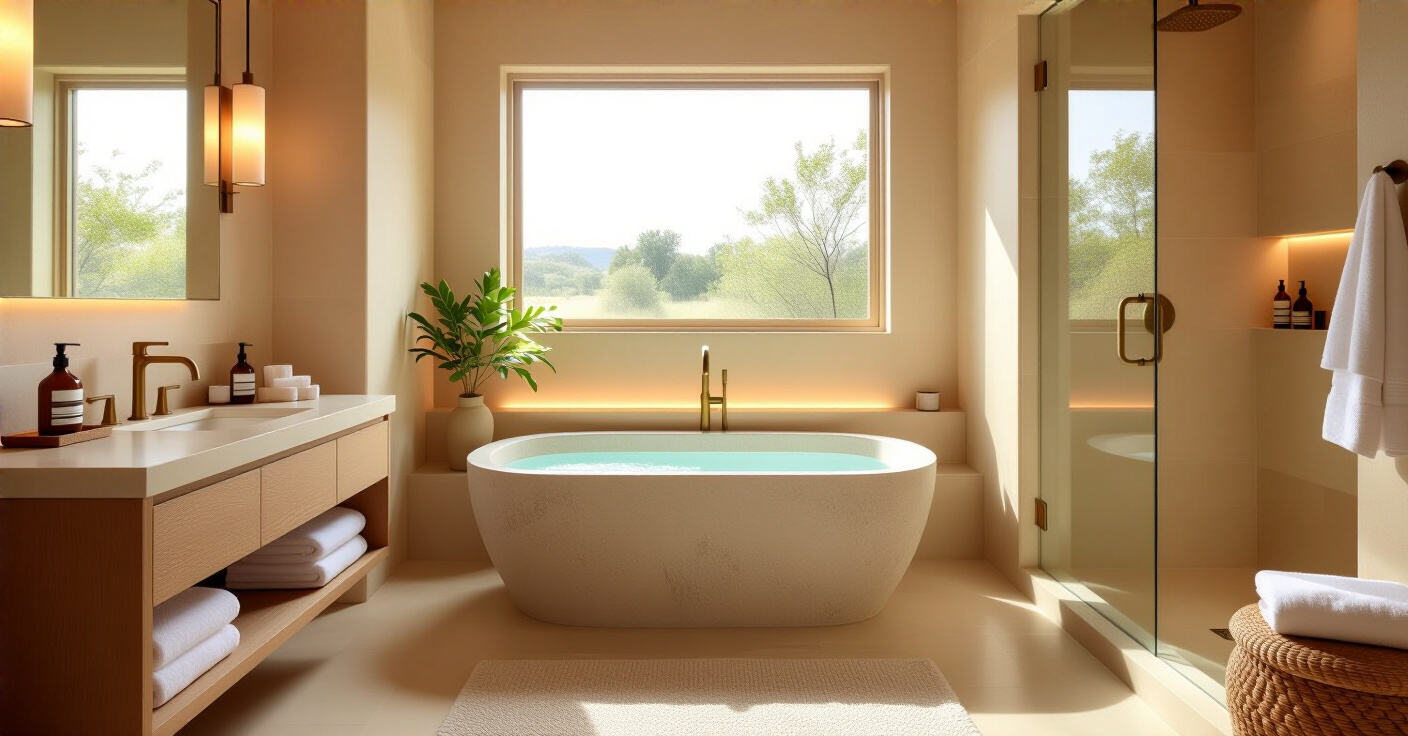
Discover 24 intentional ways to create a truly luxurious bathroom. Focus on warm minimalism, natural materials, and Scandinavian design for ultimate comfort and calm.
You know the question people always ask me? They want to know how to create a “luxury” bathroom. Then they show me pictures of spaces dripping in gold, with more jets in the shower than a fighter plane and enough marble to build a second Taj Mahal.
And I always tell them the same thing: That isn’t real luxury. It’s just noise. True luxury is not about what you see; it’s about what you feel. It is the quiet warmth of a heated stone floor on a dark January morning. It is the simple pleasure of good light. It is the calm that comes from a space where everything has a purpose and a place. So, let’s forget “opulent.” Let’s talk about what actually matters when creating a personal sanctuary in your home.
This is the most important part, and it happens entirely in your head and on paper long before a single tile is laid. Getting this right is everything. Get it wrong, and you will end up with a very expensive room that you secretly dislike using.
The noise everyone talks about is “aesthetics” and “trends.” They’ll tell you that modern farmhouse is out and brutalism is in, or something equally fleeting. Ignore all of it. This is the biggest piece of BS in design. A trend will not make you feel calm when you’re trying to unwind after a difficult day. Instead, close your eyes and ask yourself a simple question: How do I want to feel in this space?
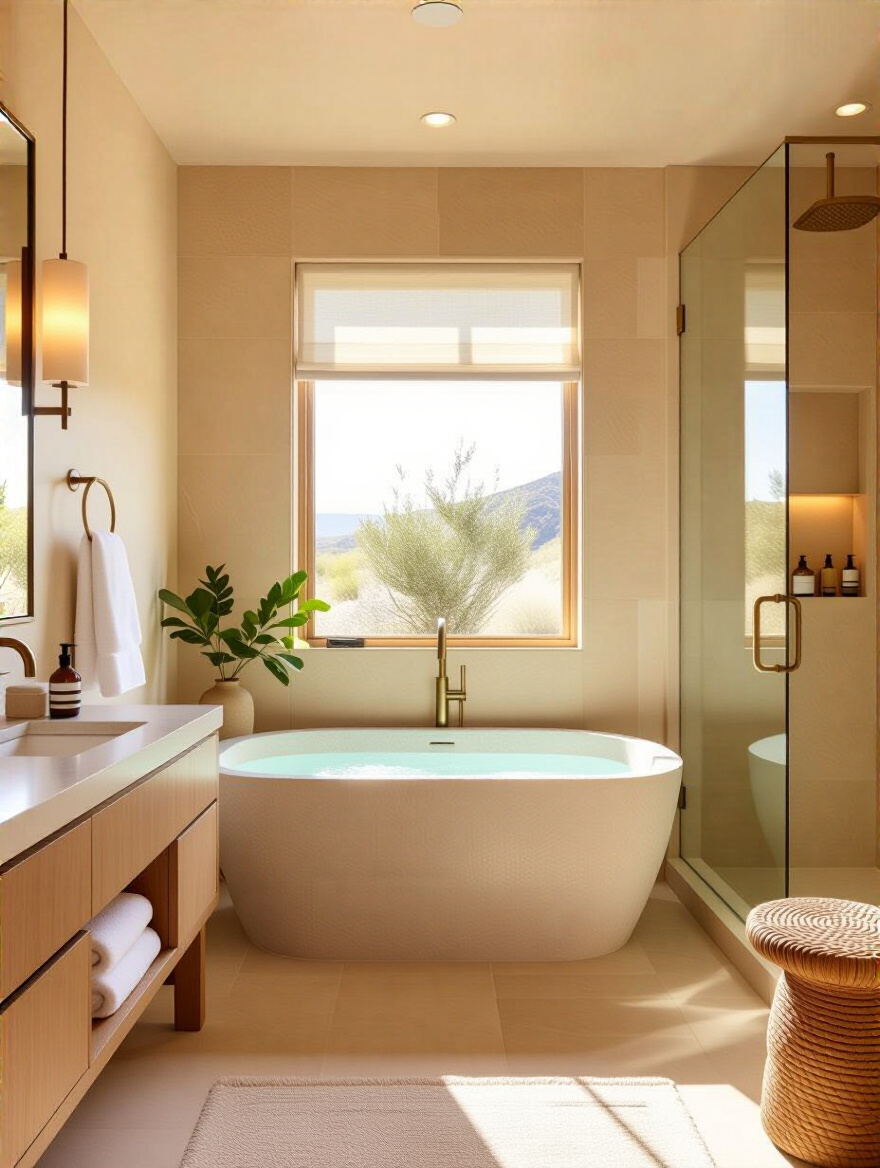
Do you want to feel energized? Calm? Connected to nature? Start there. Create a small collection of images, yes, but also textures and words. Maybe it’s a smooth river stone, a picture of a misty forest, the color of the sky just before dawn. This is your compass. I once worked with a client who was fixated on creating a hyper-modern, all-white bathroom he saw in a magazine. We talked, and I realized what he truly craved was warmth and escape. We ended up with a room of soft plaster walls, warm oak, and a single, beautiful skylight. He told me later that the first room felt like a hospital, but the second felt like a hug. That is the difference.
Design magazines love to talk about “spatial flow,” but that just means the room works without you having to think about it. You should be able to move from the door to the sink to the shower without bumping into a corner or weaving around a poorly placed tub. It sounds simple, but it is so easy to get wrong.
The shortcut is to create clear paths for your feet. Imagine you are walking through the space in the middle of the night. Can you do it easily? Think about the “wet” areas (shower and tub) and the “dry” areas (vanity and toilet). Keeping them separate makes the room feel larger, calmer, and much easier to clean. Functionality is the bedrock of good design; a beautiful room that doesn’t work is just a sculpture. And you can’t have a relaxing shower inside a sculpture.
In Scandinavia, the winters are long and dark. Because of this, we have a deep reverence for natural light. It is the most important material in any room, and it’s free. So many “luxury” designs I see ignore this. They feature small windows or heavy curtains, relying entirely on artificial light, which always feels flat and lifeless in comparison.
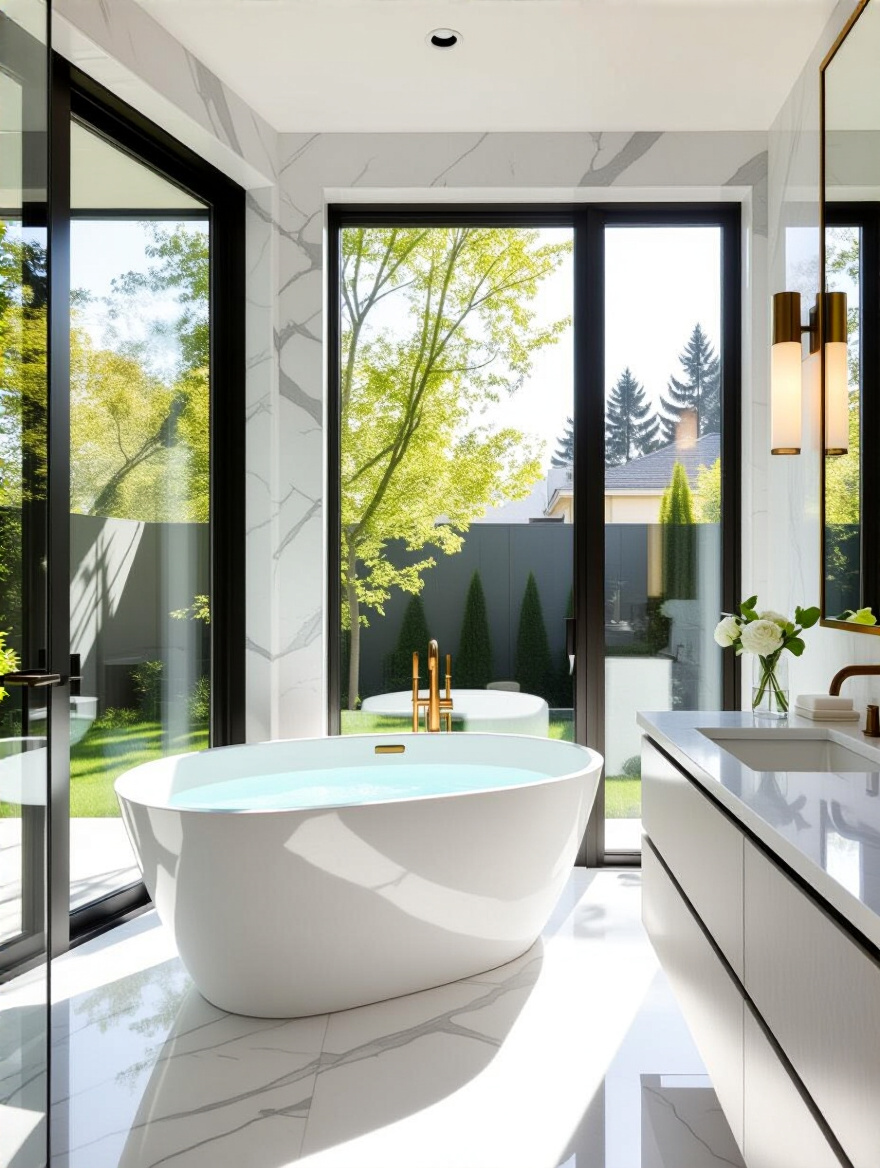
The goal is to invite as much of the outside in as you can while maintaining privacy. Think about high windows (clerestory) or a skylight over the bath or shower. There is nothing more luxurious than showering in a column of natural light. If your bathroom faces a private garden, consider a large window of frosted or reeded glass. It blurs the view but lets the beautiful, soft light pour in, connecting you to the patterns of the day.
A truly serene space is an uncluttered one. That means the plumbing, the extra toilet paper, and the half-empty bottle of shampoo should be invisible. This isn’t about pretending they don’t exist; it is about creating a sense of visual peace so you can appreciate the beautiful, simple things instead.
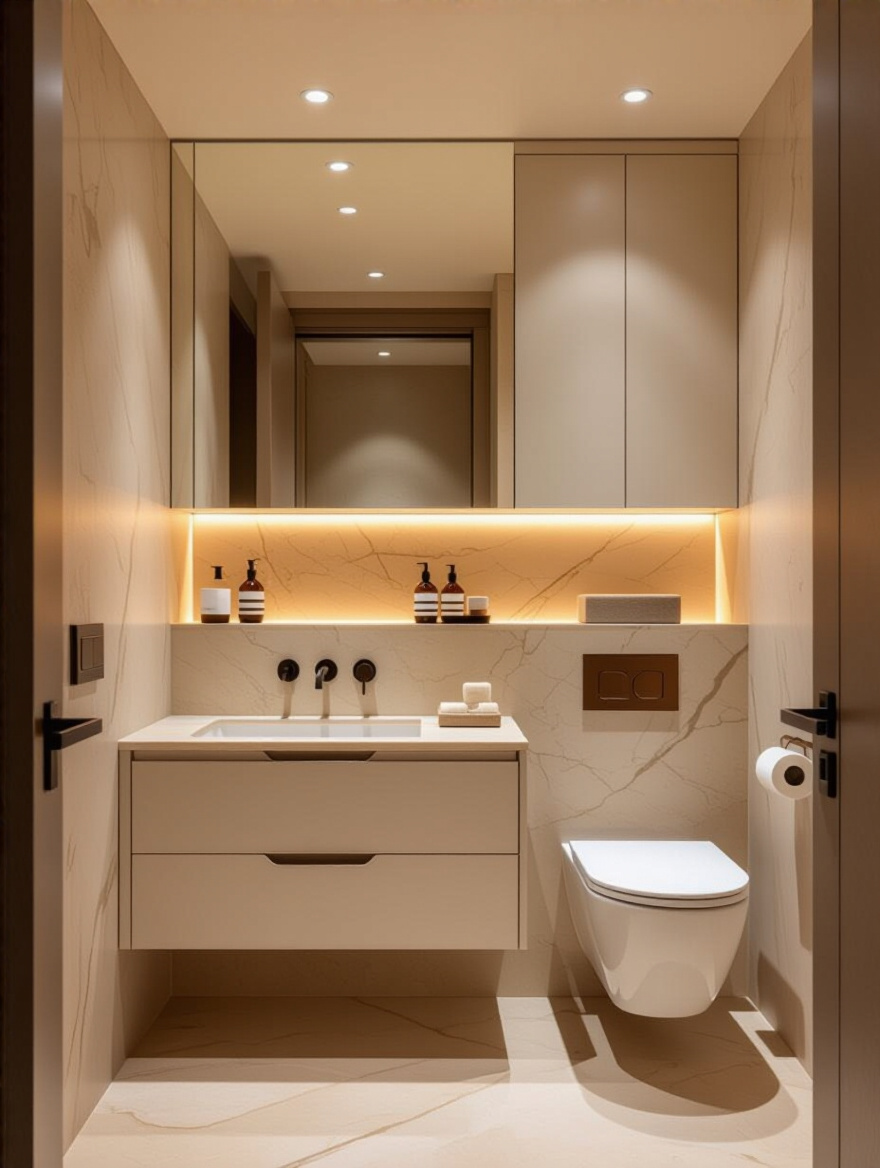
The key is to plan this from the very beginning. Use a wall-mounted toilet where the tank is hidden inside the wall. Choose a vanity that floats off the floor. This not only hides the plumbing but creates an unbroken floor surface, making the room feel larger and more open. I learned this the hard way on an early project where we left the pipes under the sink exposed for an “industrial” look. The client hated it. It just looked unfinished and messy, a constant reminder of mechanics instead of calm. A simple panel of wood to hide it changed the entire feel of the room.
Once you have the big pieces of the puzzle—the light, the flow, the storage—it’s time to refine the feeling of the space. These next steps are what elevate a functional room into a true personal escape.
We live in a loud world. Your bathroom should be a place where you can escape that noise. So often, this is completely overlooked. What good is a beautiful soaking tub if you can hear the television blaring from the next room or water rushing through pipes in the wall? It completely shatters the illusion of escape.
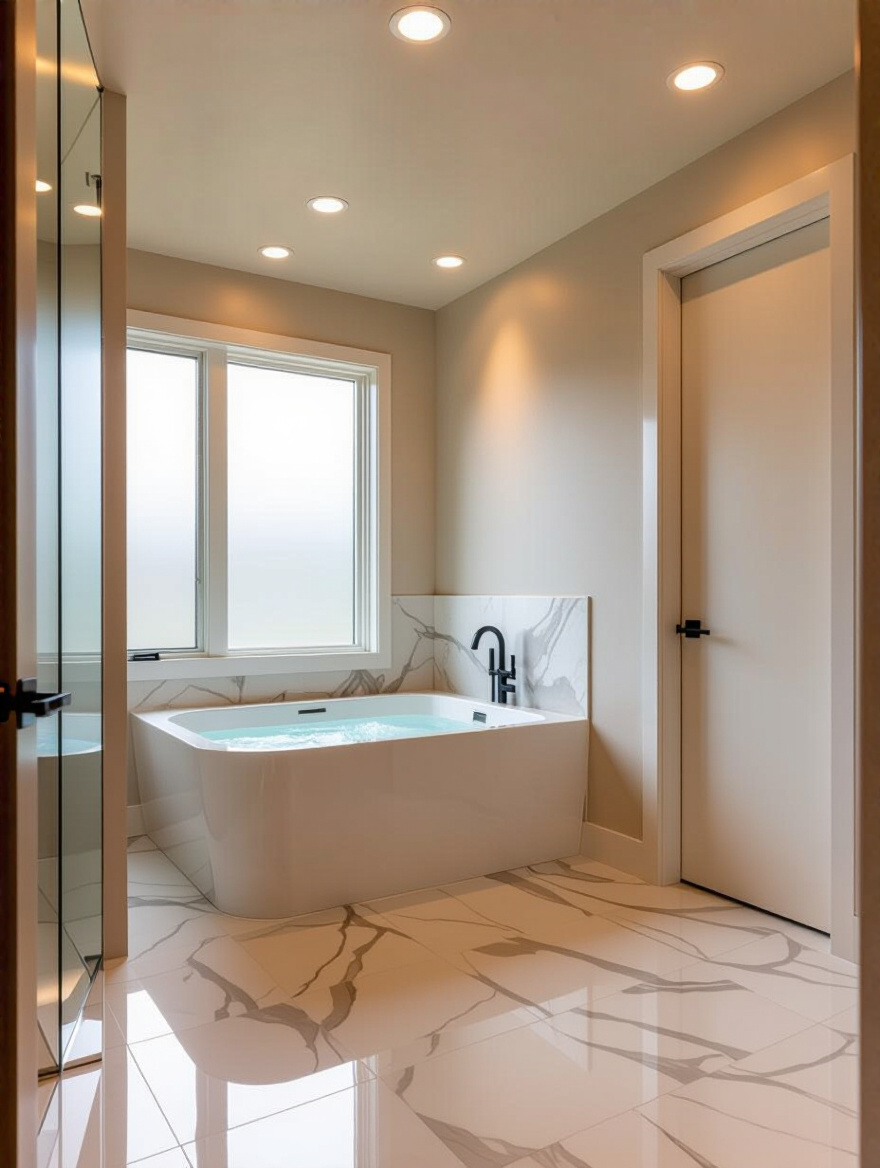
Soundproofing isn’t as difficult as it sounds. It can be as simple as using solid-core doors instead of hollow ones and adding insulation to the interior walls during a renovation. These small changes make a profound difference. The silence they create becomes a key ingredient in the room’s atmosphere of relaxation. A quiet room allows your mind to settle. That is a luxury no amount of money can buy if you haven’t planned for it.
This sounds technical, but it’s quite intuitive. It’s about giving each activity its own dedicated home. A very common and effective approach in Nordic design is the concept of a “wet room,” where the shower and tub are combined in one fully waterproofed, glass-enclosed area. This contains all the water and steam, feels wonderfully open, and visually separates the “washing” zone from the “grooming” zone.
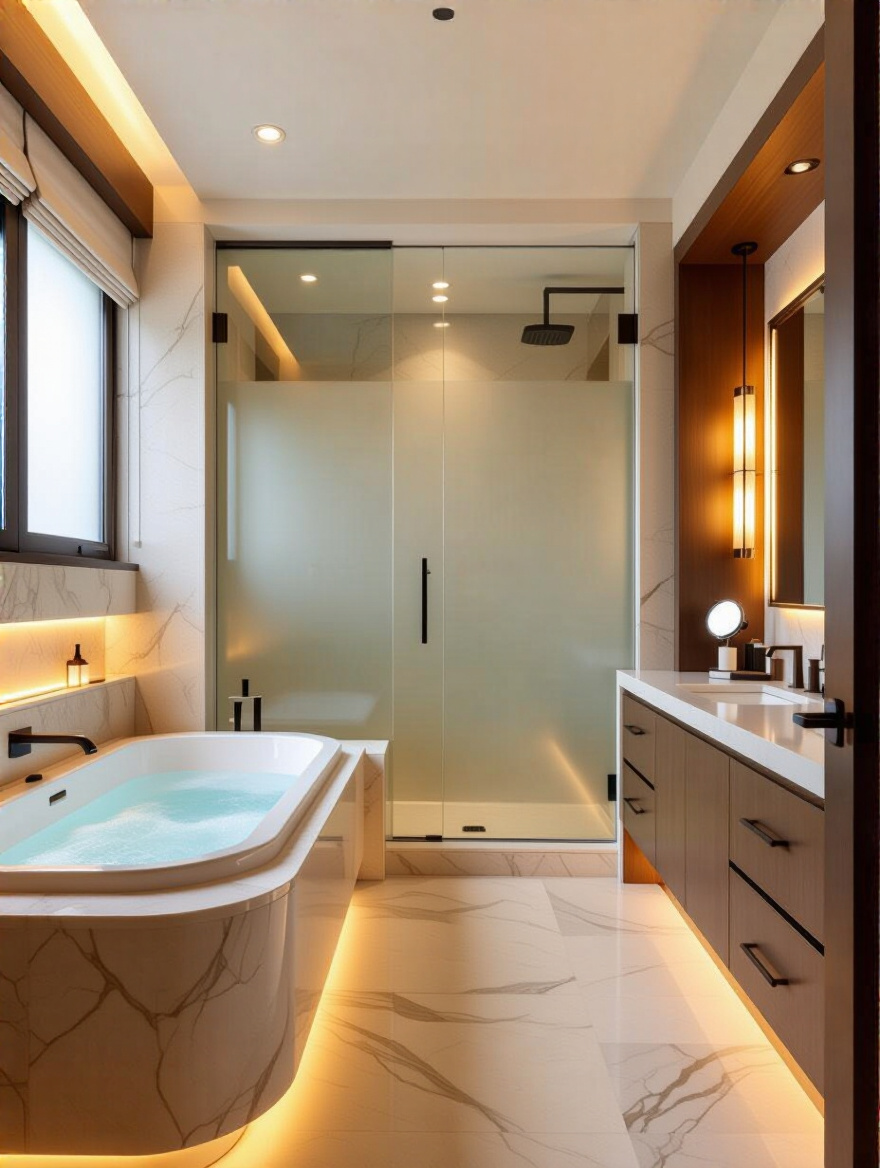
This zoning doesn’t have to be so literal. You can use a change in flooring material, a slight step up, or even just a shift in the lighting to signal a new area. The vanity area might have bright, clear task lighting, while the bathing area has a soft, dimmable glow. This subtle separation helps your mind shift gears, turning the simple act of washing your face or taking a bath into a more mindful, deliberate ritual.
This is where people often get carried away. The secret isn’t to buy the most expensive thing, but to choose simple, high-quality items that are a pleasure to use and look at every single day.
Many people see a freestanding tub as just a big, expensive sculpture. They choose a shape that looks dramatic but is uncomfortable to actually sit in. What is the point of that? The true purpose of a tub is for a deep, quiet soak. So, its function comes first.
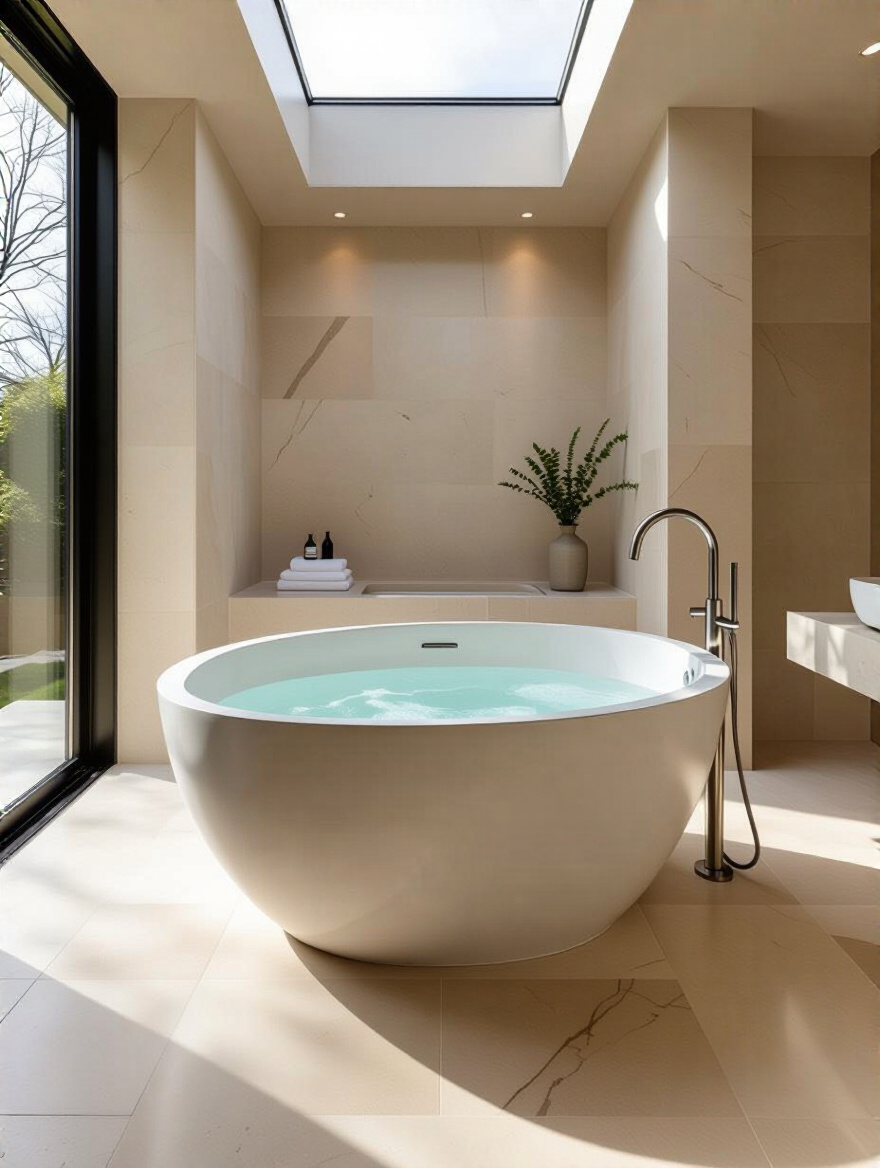
Find one that is shaped for the human body, deep enough to cover your shoulders, and made from a material that holds heat well, like stone resin or even modern acrylic. The luxury here isn’t impressing guests; it’s the 30 minutes of uninterrupted peace you get while soaking in warm water. And please, place it where you have something beautiful and simple to look at—a window, a single piece of art, or even just a blank wall.
Here is my pet peeve with so-called luxury showers: they have a dozen jets spraying at you from every direction. It’s a car wash, not a relaxing experience. It is complicated, it is impossible to clean, and something is always breaking. All of that is just noise.
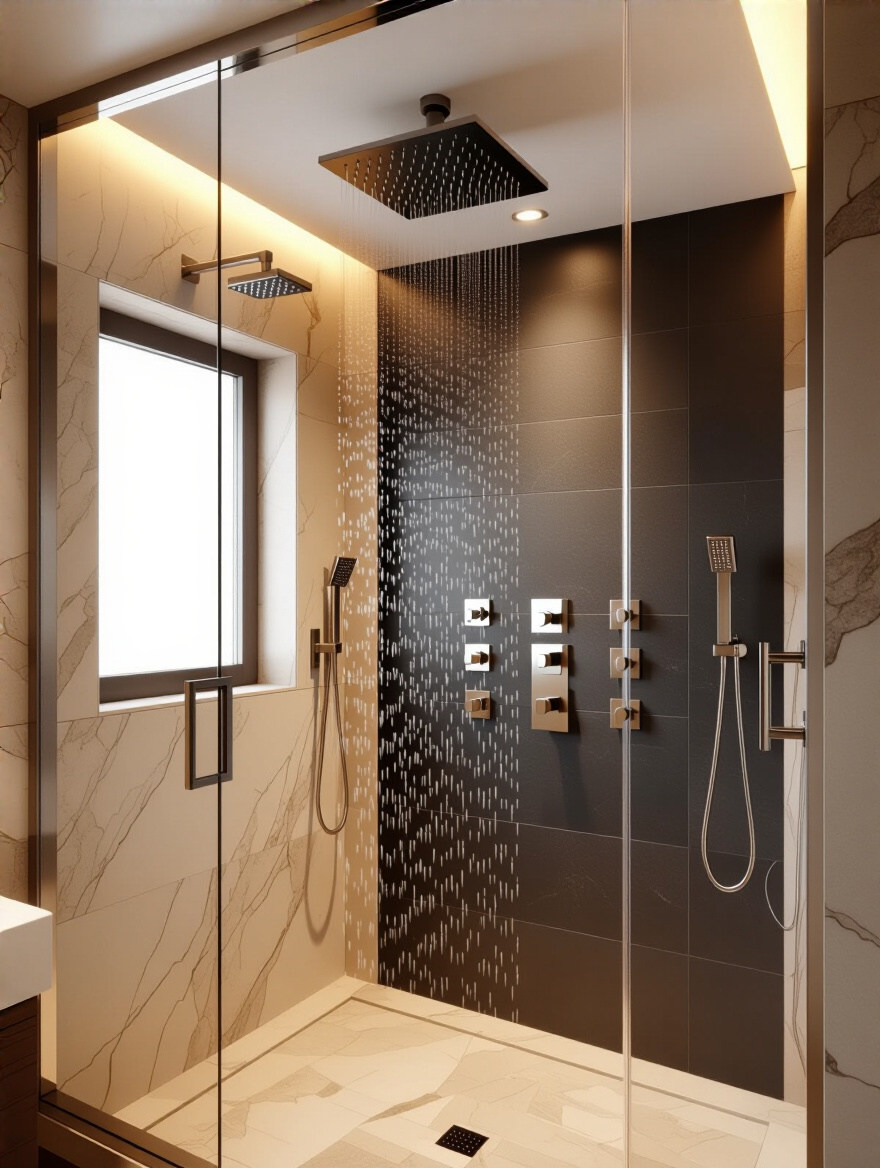
The truth is, you only need one thing: a single, high-quality shower head with good pressure that feels like a warm, heavy rain. That’s it. Invest your money there, in a well-engineered fixture from a reputable brand. When you get the fundamentals right, you don’t need all the distracting gimmicks. A perfect, simple stream of hot water is one of life’s great, simple pleasures.
If you share a bathroom, a double vanity isn’t a luxury; it is a necessity for a peaceful relationship. Having your own sink and your own space is fundamentally practical. It removes a major source of daily friction. But its real value lies in the storage beneath it.
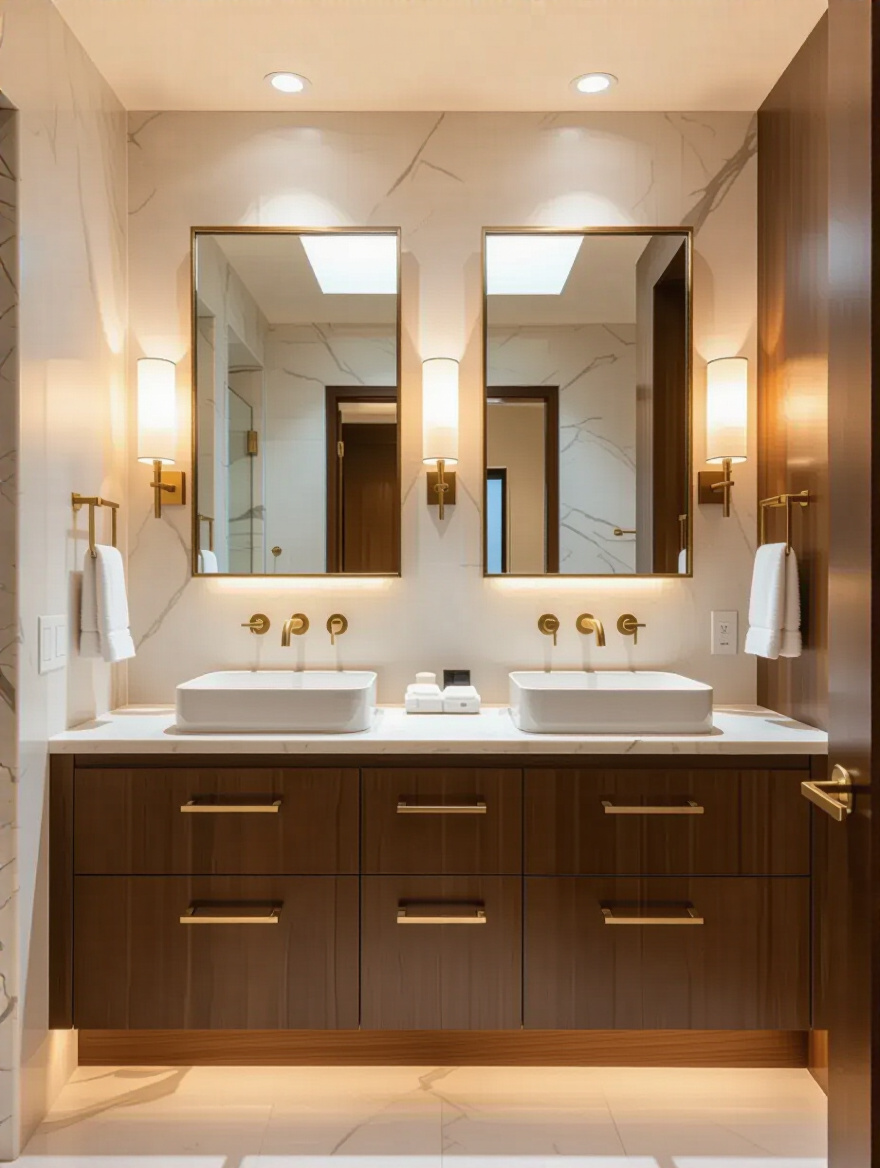
The mistake most people make is choosing a beautiful vanity that has no functional drawers or cabinets. A pedestal sink looks elegant until you realize you have nowhere to put anything. A good vanity has deep drawers, thoughtfully divided, so that everything has a home and the countertop can remain completely clear. An ordered space creates an ordered mind.
Materials like marble and stone are popular for a reason, but not just because they look expensive. They have a connection to the earth that feels grounding. The luxury is in the tactile experience—the cool, smooth feel of honed stone under your feet, the solid weight of it.
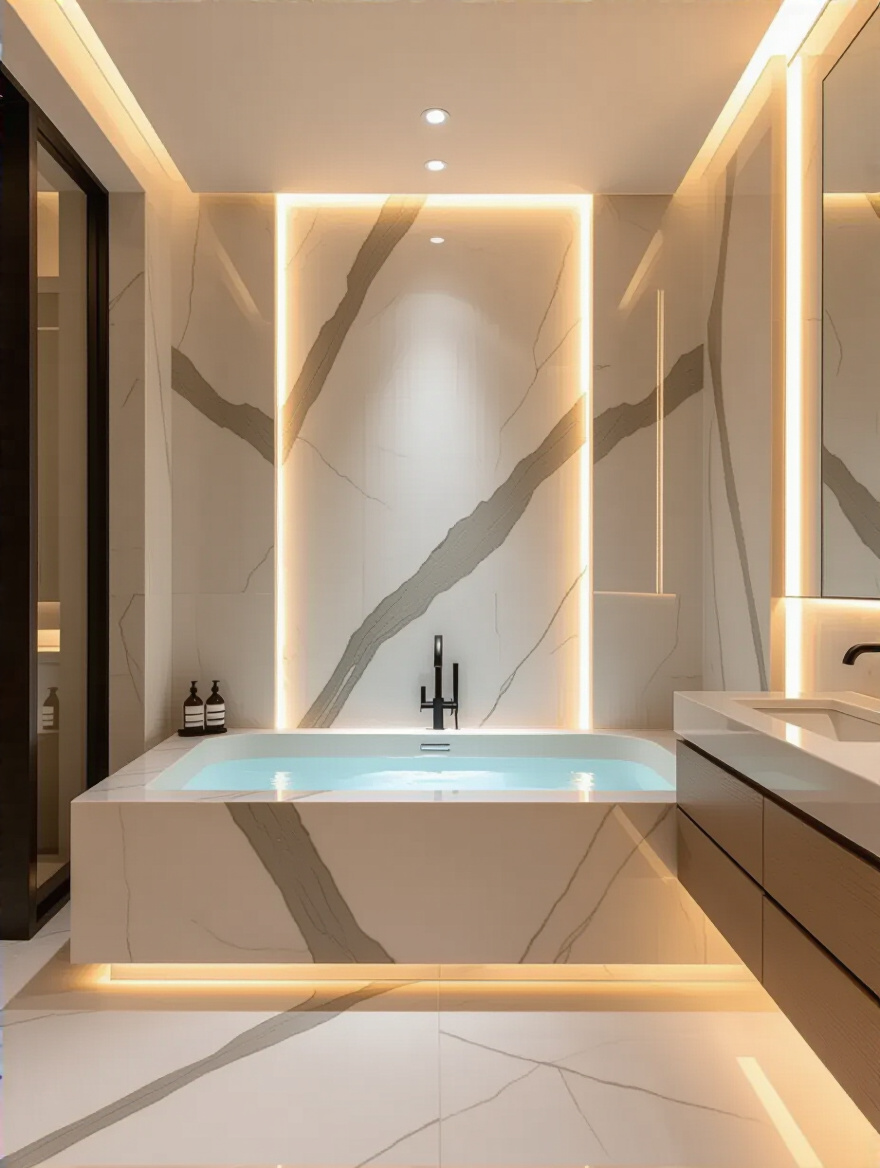
But you don’t have to use marble to achieve this. High-quality porcelain is an incredible material. It’s durable, easy to care for, and can mimic the look of natural stone or wood so well that it is hard to tell the difference. I recommend large-format tiles. Using bigger tiles means fewer grout lines, which creates a more seamless, monolithic look that is incredibly calming to the eye and so much easier to keep clean.
These are the details you’ll interact with every day. They might seem small, but their cumulative effect is huge. This is where quality really sings.
The faucets and handles are the parts of the bathroom you will touch every single day. People call them the “jewelry” of the room, but I think of them as the handshake. A cheap, flimsy faucet feels terrible to use. A well-made, solid brass one with a smooth mechanism feels satisfying and reliable.
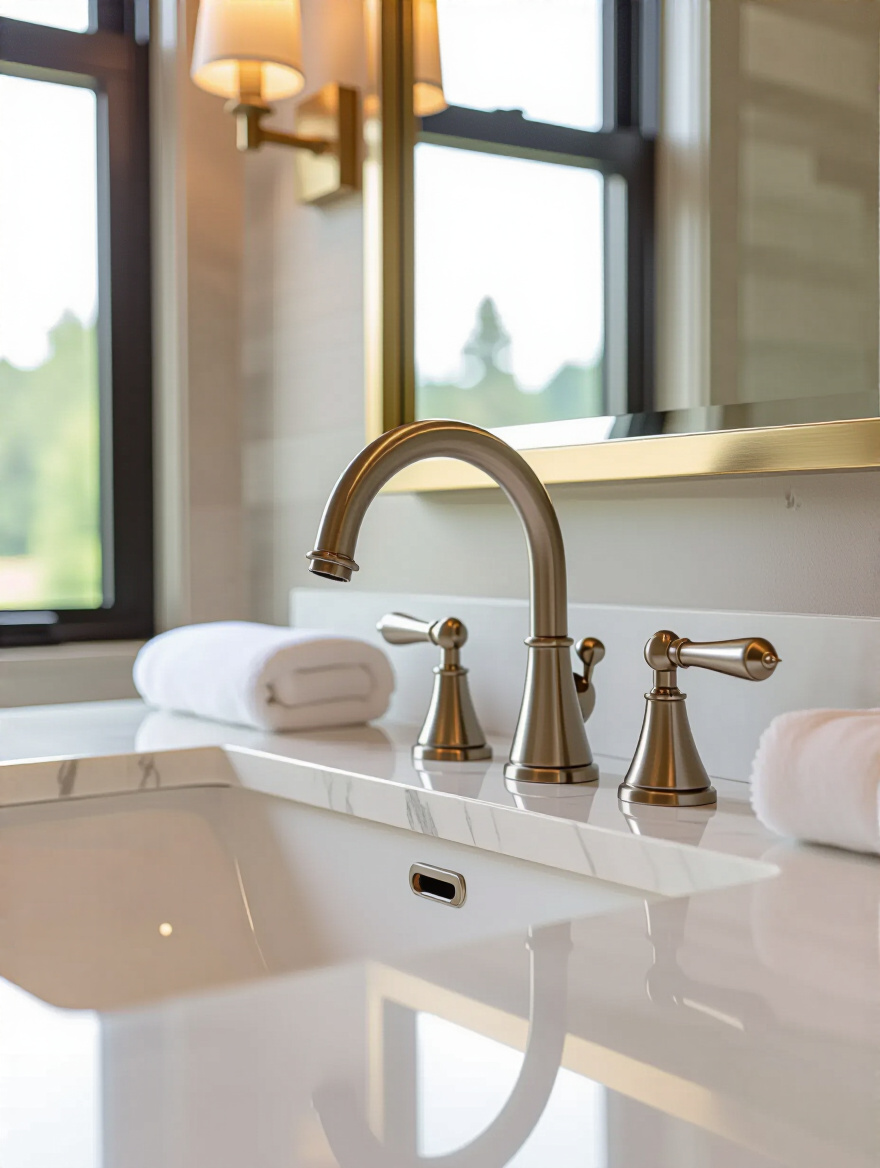
Choose a simple, timeless design in a finish that feels good in your hand. And be consistent. Use the same finish for your faucet, your shower controls, your towel bar. This simple act creates a sense of cohesion and intention. It shows that every detail was considered, which is the very definition of thoughtful design. This is a place where spending a little more on quality makes a huge difference in your daily experience.
If you live in a place with cold winters, heated flooring is not a luxury, it is a fundamental component of comfort. I cannot stress this enough. Stepping out of a warm shower onto a cold, hard tile floor is a miserable experience. Stepping onto a floor that is silently radiating gentle warmth is sublime.
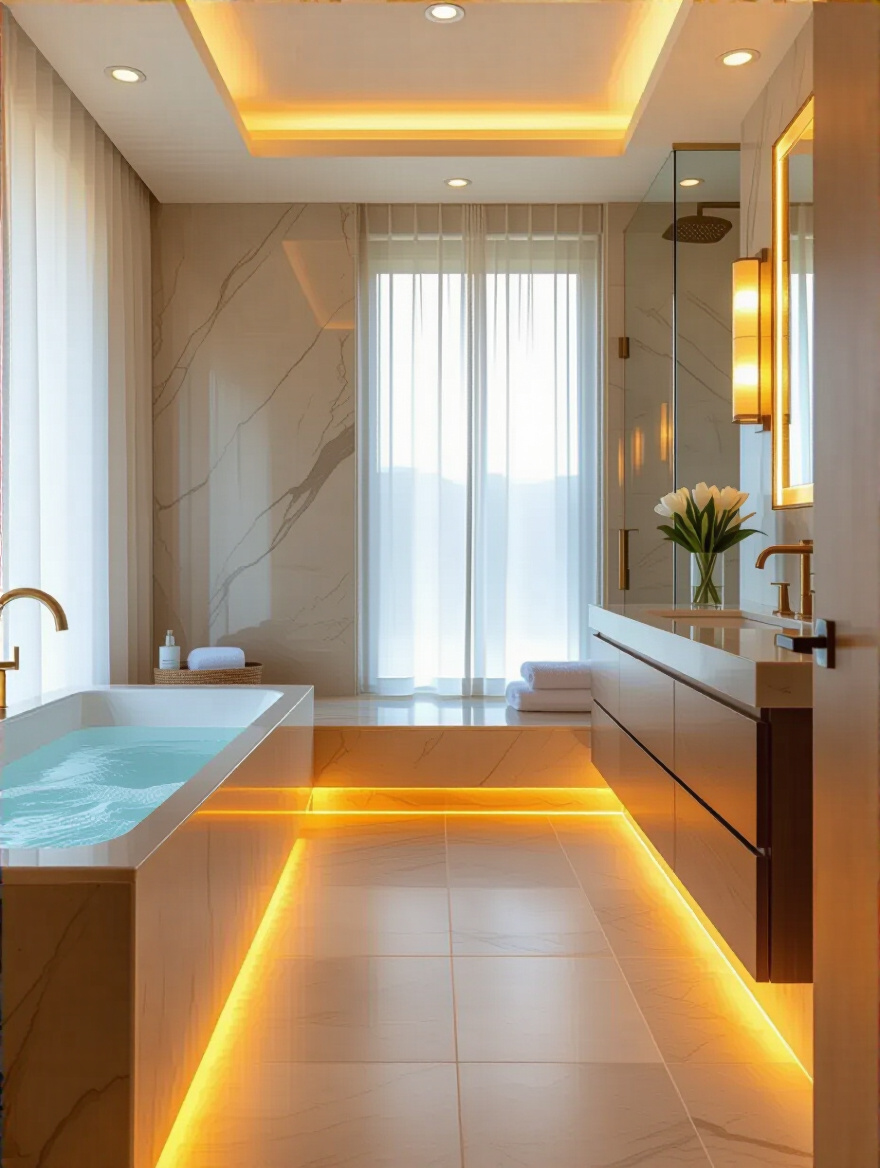
It’s an invisible technology that has a profound impact on how the room feels. It provides an even, draft-free heat that is far more comfortable than forced air from a vent. Honestly, if a client gives me a budget and says they can have a fancy tub or heated floors, I tell them to choose the floors. Every single time. They will thank me for it every morning from November through April.
Technology should serve you, not complicate your life. In the bathroom, it should be seamless and intuitive, working in the background to make the space more comfortable and adaptable.
A single, harsh overhead light is a design crime. It casts unflattering shadows and offers no flexibility. A well-lit bathroom, like any room, needs layers of light that you can control. You need bright, clear task light by the mirror for grooming. You need soft, ambient light for the overall space. And you might want a small accent light, perhaps in a shower niche or under the vanity, for a gentle glow at night.
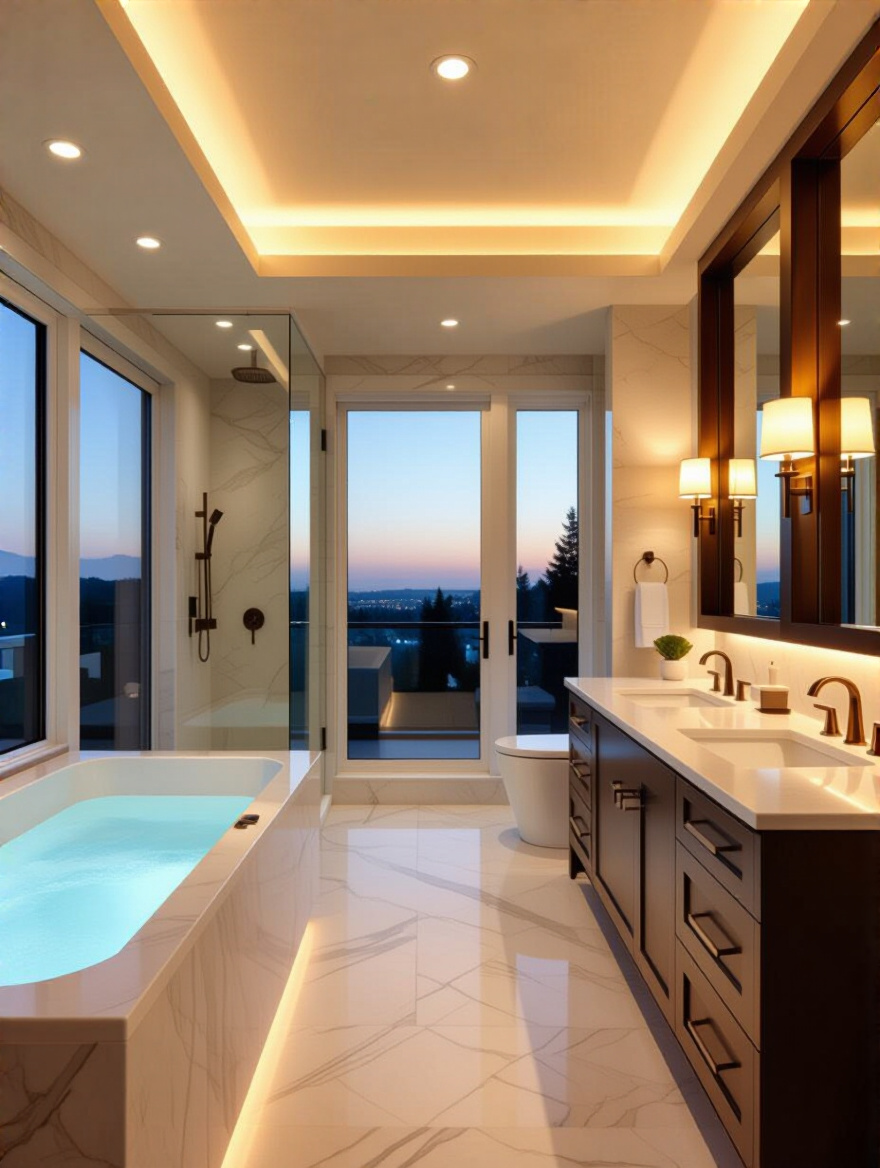
Most importantly, put everything on a dimmer. This is the single most effective tool for changing the mood of a room. You want bright, clean light in the morning to help you wake up, and a very warm, low light in the evening to signal to your body that it’s time to wind down. The ability to control your light is the ability to control your mood.
A foggy mirror after a shower is a small but constant annoyance. An anti-fog mirror, which has a small heating element behind it, is a simple, brilliant solution. It removes a point of friction from your daily routine. That is what good technology does.
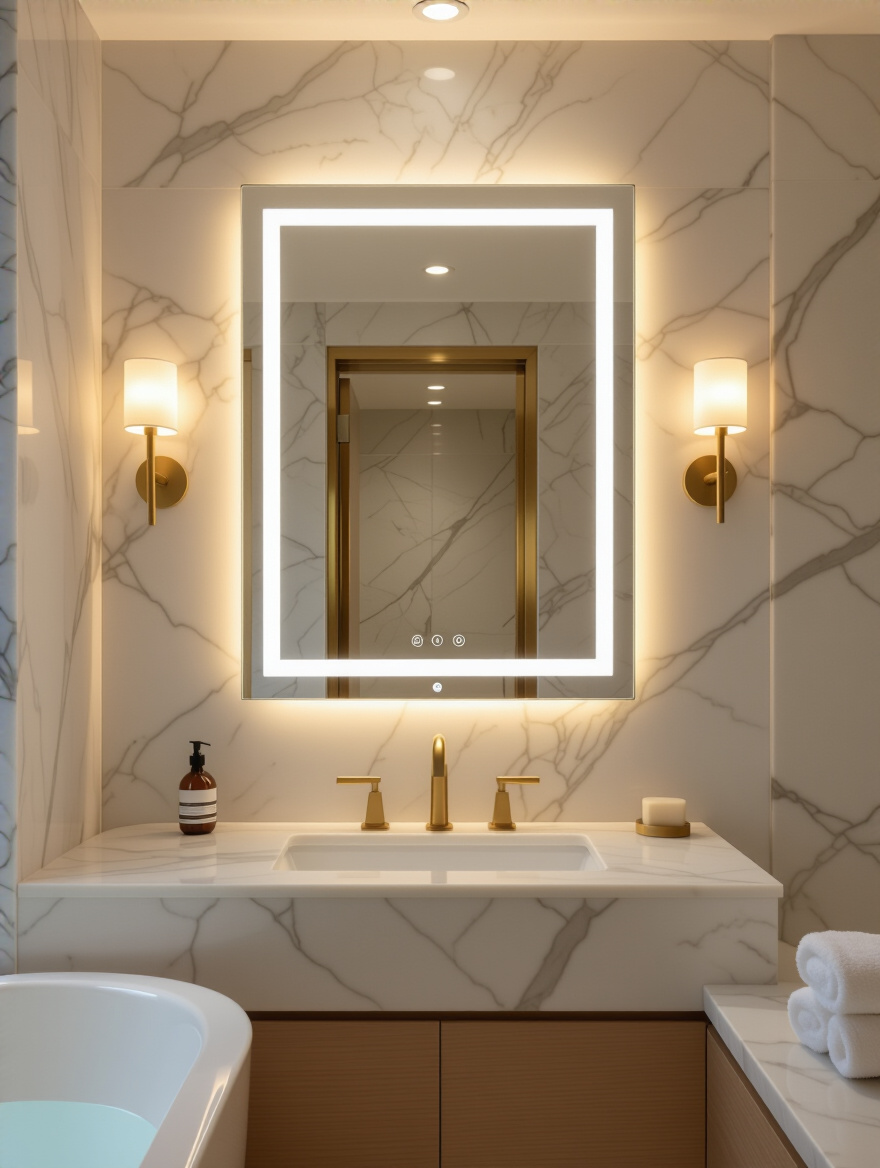
Many of these now come with integrated lighting, which can be fantastic for task lighting around the face. It provides even, shadow-free illumination. My only caution is to avoid the ones that try to do too much. Do you really need to read the news or check the weather on your bathroom mirror? Probably not. The true luxury is a clear reflection and perfect light, not another screen.
Similar to the warm floor, having smart climate control simply means the room is always comfortable without you ever having to think about it. It can be programmed to warm the room up a few degrees right before you wake up in the morning.
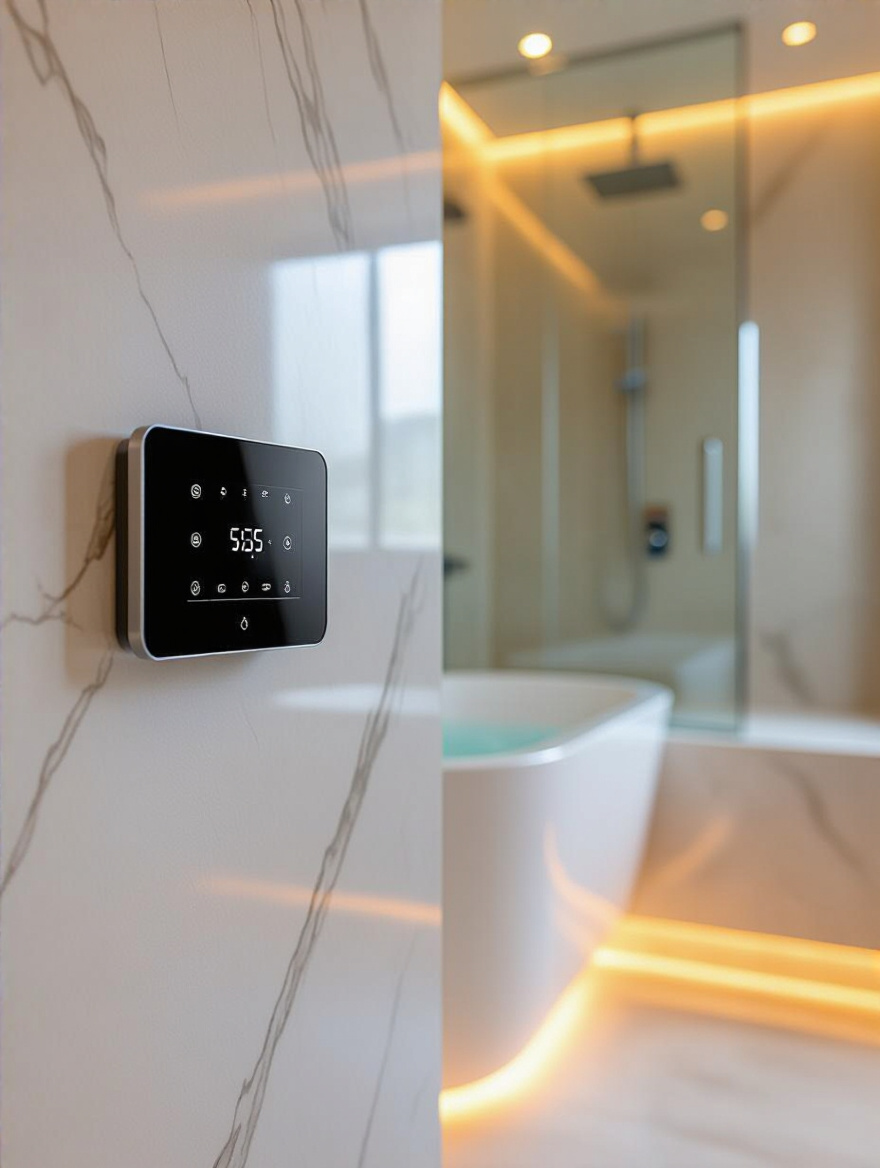
Even more importantly, it should include a humidity sensor. The system can automatically turn on the ventilation fan when it senses steam from the shower and turn it off once the air is clear. This protects your beautiful wood cabinets and prevents mold, all without a thought from you. It’s quiet, background intelligence that enhances both comfort and the longevity of the room.
Some people want total silence in their sanctuary. Others want to listen to soft music or a podcast. Either way, a built-in sound system can deliver that without clutter. Small, moisture-resistant speakers can be installed flush in the ceiling, completely out of sight.
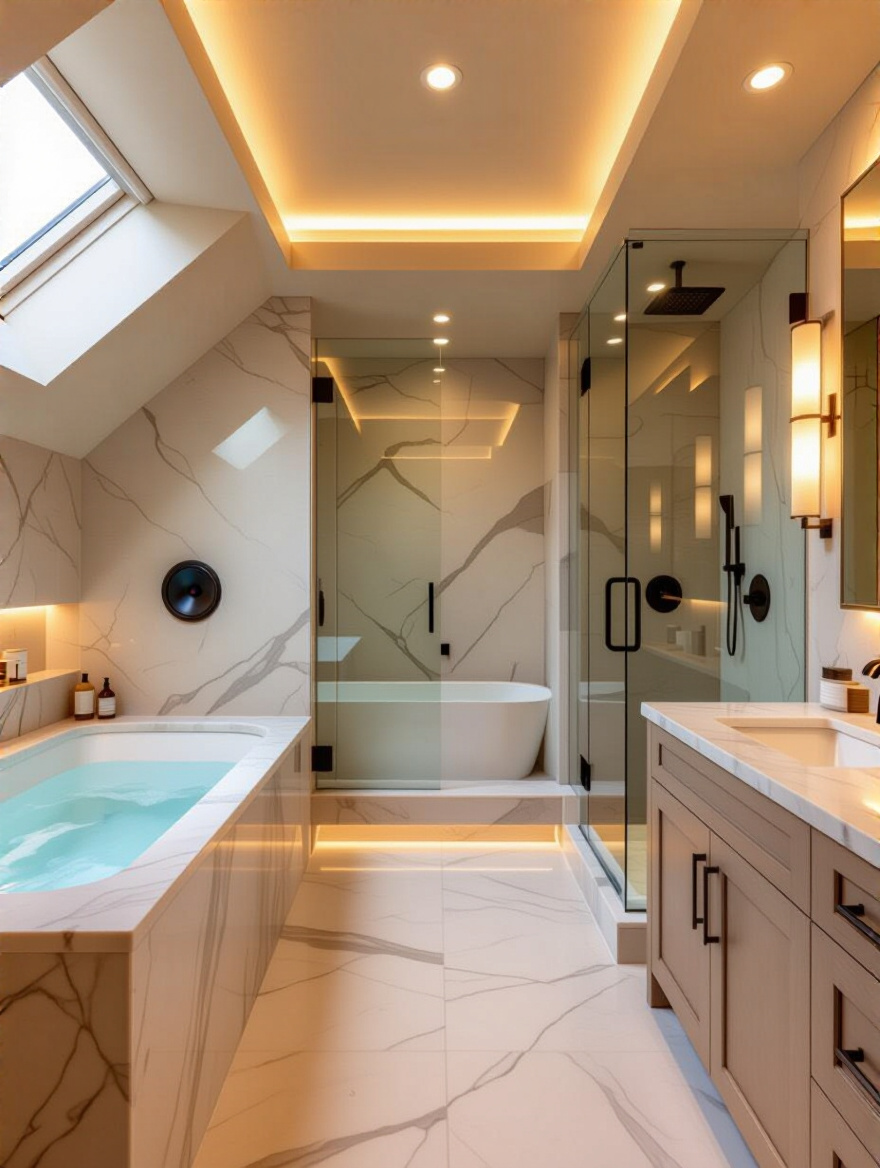
They can connect via Bluetooth to your phone, giving you an invisible way to layer in another sensory element. Imagine soaking in the tub while listening to the sound of rainfall or a peaceful piano score, with the source of the sound completely hidden. This is technology serving the experience, not distracting from it.
The most advanced technologies are often the ones you notice the least. They are about efficiency, responsiveness, and making sustainable choices feel effortless.
There is no luxury in wastefulness. The most sophisticated bathroom designs today are also the most sustainable. Modern fixtures can give you a wonderful experience while using a fraction of the water of older models. A good low-flow showerhead can feel just as powerful as a wasteful one by aerating the water.
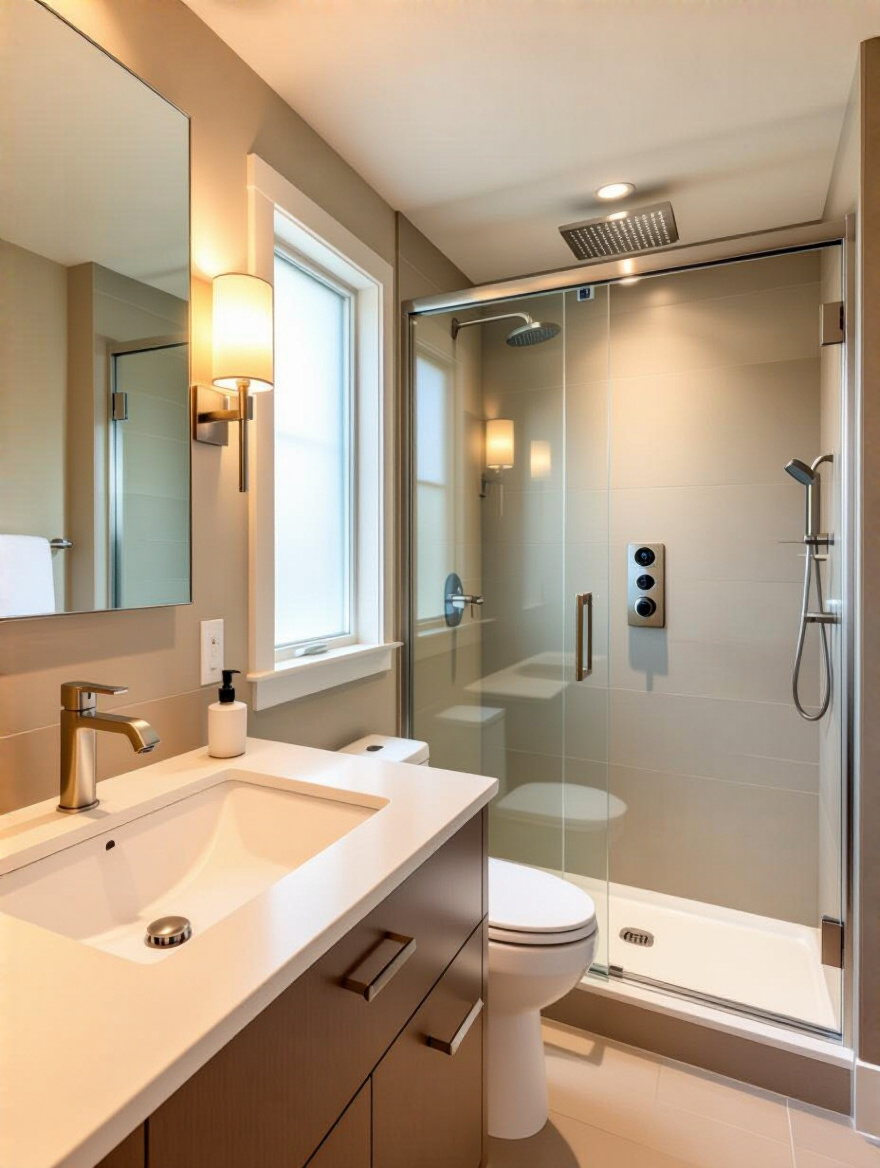
Smart sensors on faucets are also a great choice, especially in a powder room used by guests. The water runs only when hands are under it, which is both hygienic and incredibly efficient. This isn’t about sacrificing comfort; it’s about embracing intelligent design that respects our resources. That mindfulness is a form of luxury in itself.
If you are lucky enough to have a large window in your bathroom, you will want an easy way to control it. Automated shades are a wonderful solution. With a simple press of a button, you can have complete privacy or let the morning light stream in.
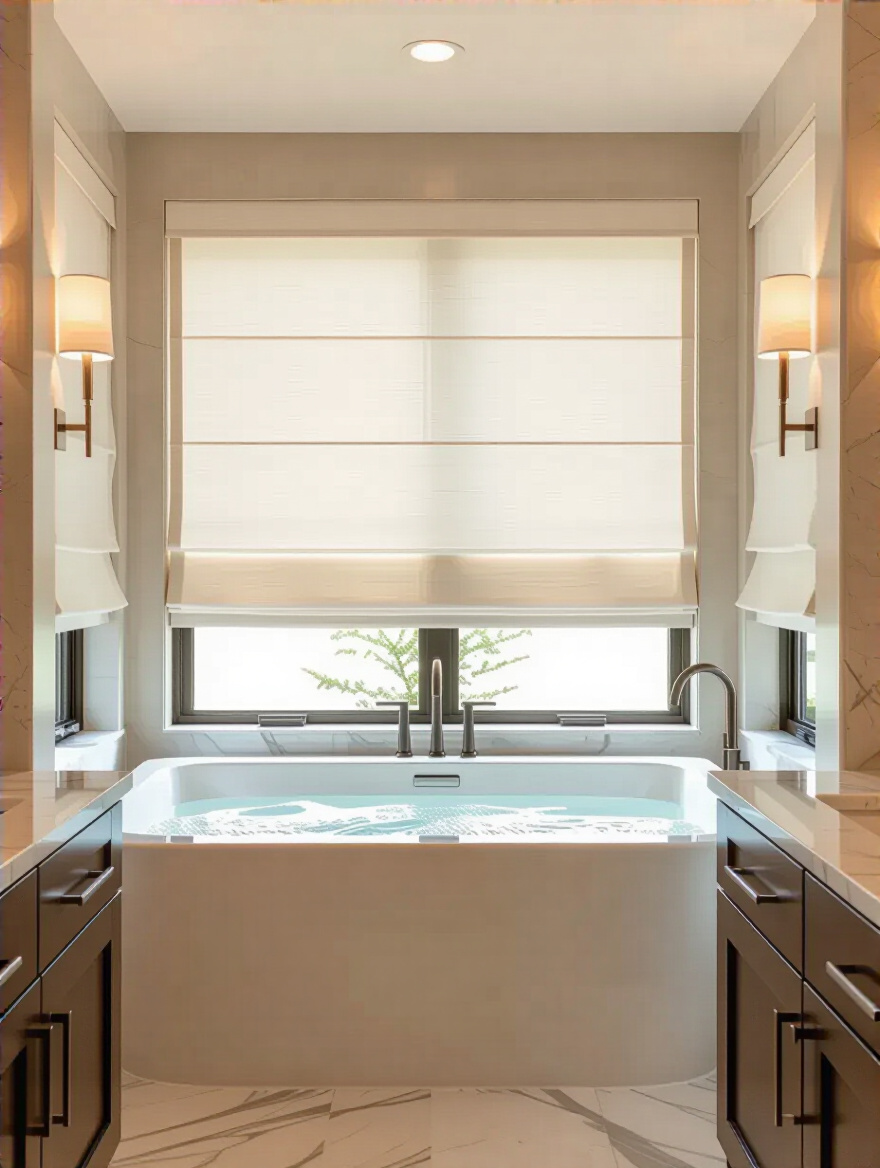
You can even program them to open and close at certain times of day. They can be set to lower during the hottest part of the afternoon to keep the room cool or rise with the sun to help you wake up naturally. It’s a seamless way to manage the connection between your private sanctuary and the outside world.
This is the final layer. It is about the small objects and sensory details that make the space feel deeply personal and restorative.
A bathroom shouldn’t feel sterile like a laboratory. It needs a touch of humanity. This doesn’t mean you need to buy an expensive “sculptural element.” It could be a simple, beautiful stool made of reclaimed wood next to the tub. It could be a small ceramic vase with a single green branch.
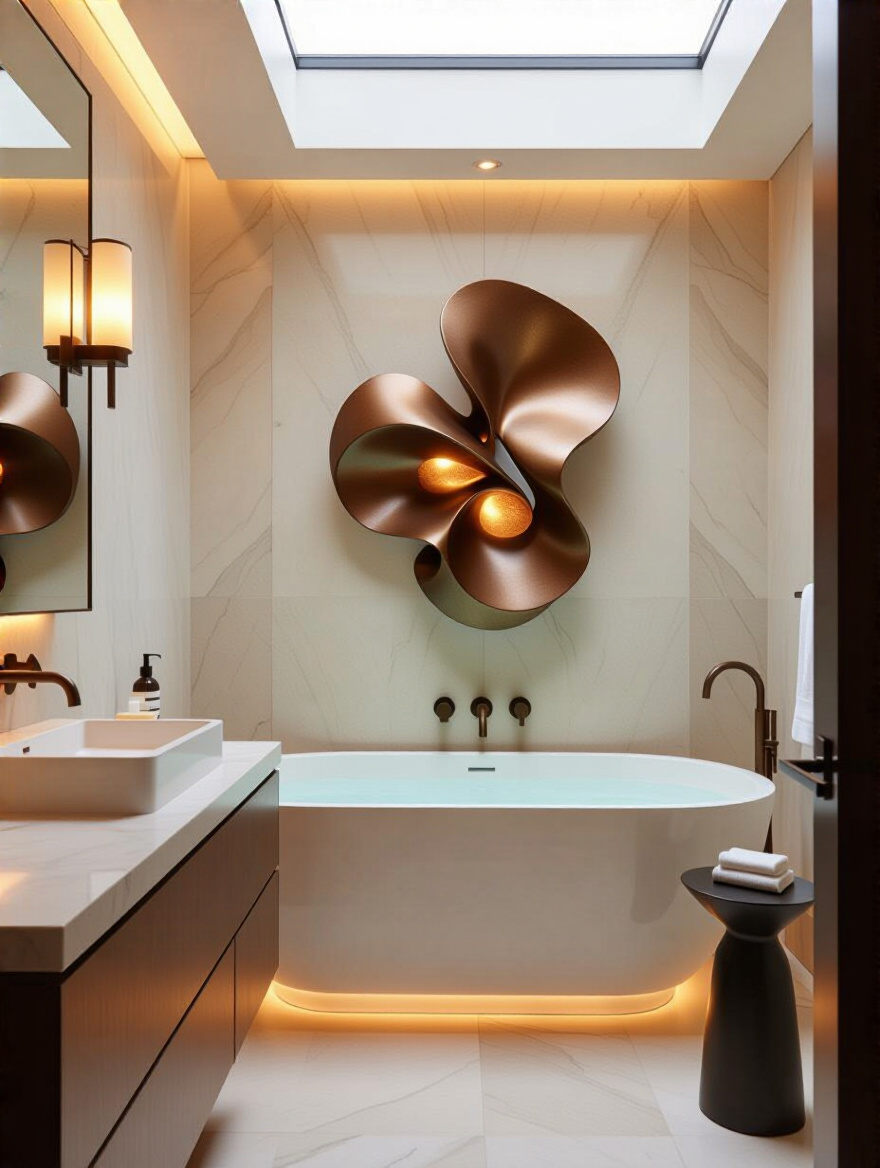
Choose one or two things that have a personal meaning or a natural beauty you love to look at. A client of mine placed a single, large, smooth, grey stone she found on a beach on the edge of her tub. It cost nothing, but it held a memory and a connection to nature. It was the most commented-on piece in the entire room.
Never underestimate the power of a truly excellent towel. This is a small detail that has a huge impact on your daily experience. You want towels that are soft, absorbent, and generously sized.
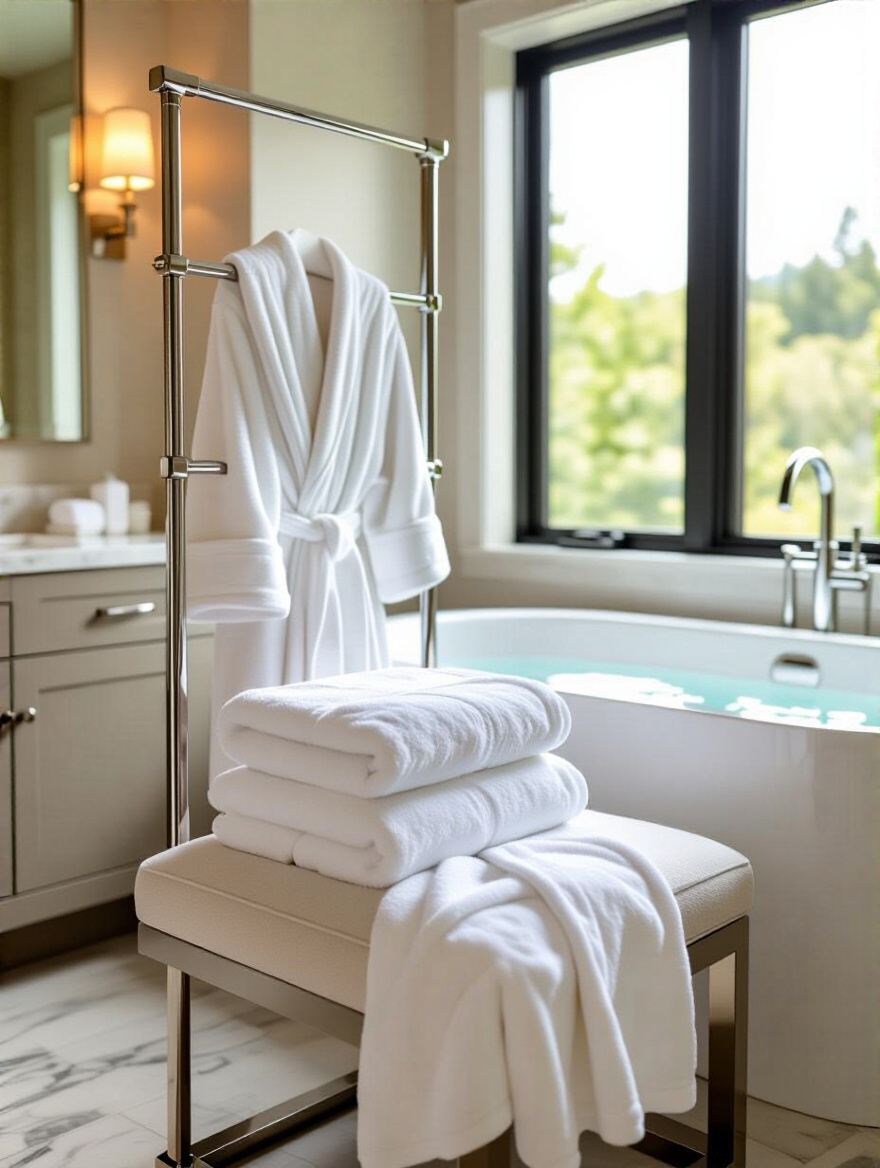
Look for high-quality cotton, like Egyptian or Turkish, and pay attention to the weight (measured in GSM). A heavier towel feels more substantial and luxurious. And buy all white. They look clean and calm, they can be bleached if needed, and it gives the space a cohesive, hotel-like feel. This is a small investment that pays you back in comfort every single day.
Scent is powerfully tied to memory and mood. A subtle, natural fragrance can complete the sensory experience of your bathroom. The key here is subtlety. Avoid synthetic plug-in air fresheners, which are overwhelming and artificial.
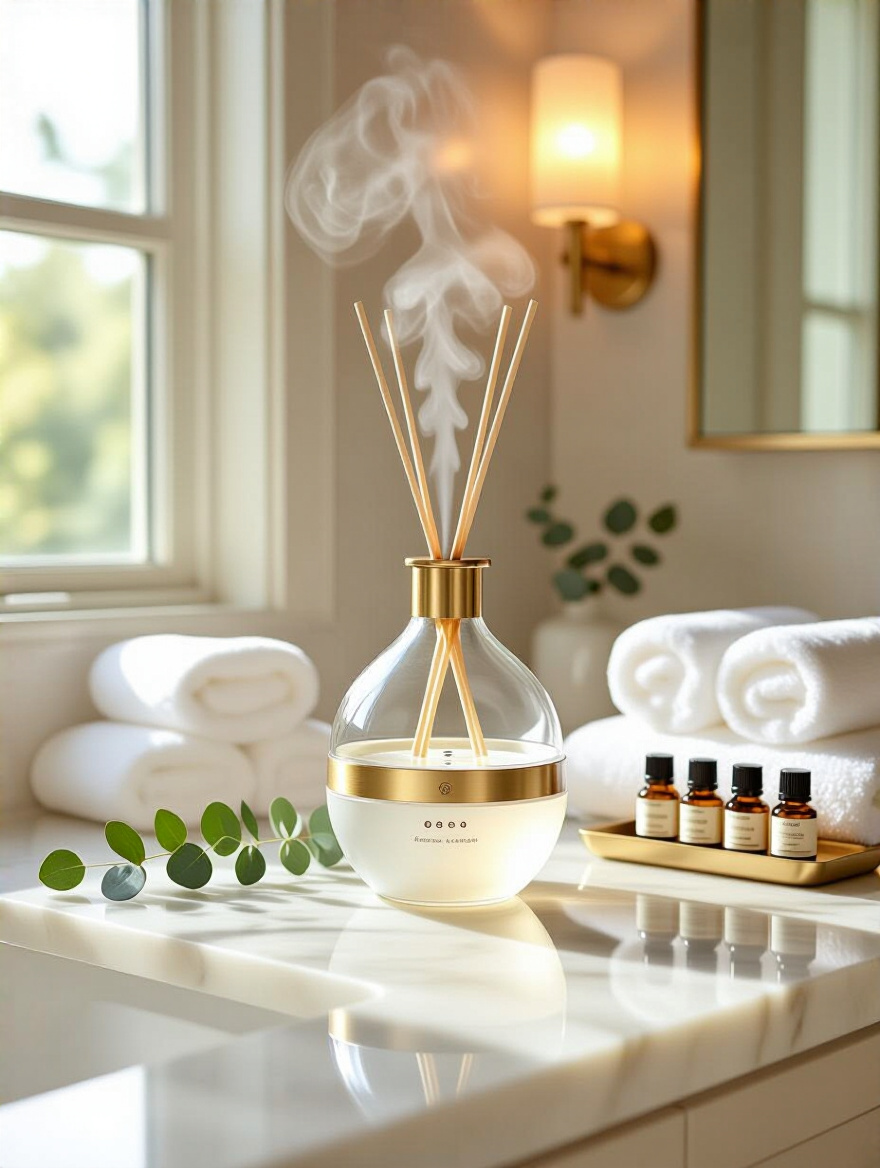
A simple ultrasonic diffuser with a few drops of a pure essential oil is a wonderful tool. Use calming scents like lavender or cedarwood in the evening, or something bright and clean like eucalyptus or grapefruit in the morning. The scent should be something you barely notice, a faint, pleasant background note that enhances the feeling of clean tranquility.
Every room benefits from the presence of a living thing. In a bathroom, with its high humidity, many plants will thrive. Adding a plant is the quickest and easiest way to introduce life, color, and a connection to the natural world into the space.
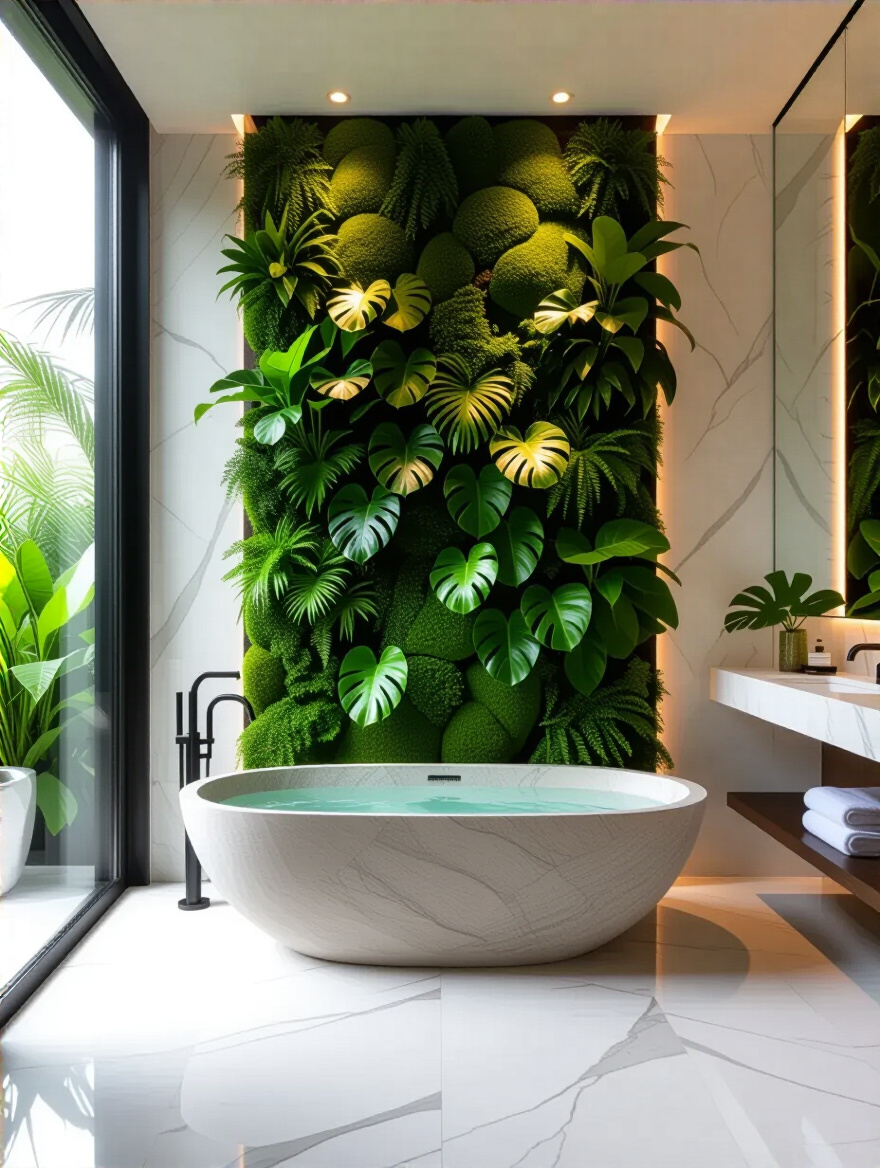
Choose a plant that suits your light conditions. A fern, a snake plant, or an orchid can do beautifully in the warm, damp environment. Place it in a simple, beautiful pot. It will not only purify the air but also soften all the hard surfaces of tile and stone, making the room feel alive and breathing.
This is about curating your daily rituals. The final touches transform the space from a room you use into a space that serves you.
Look at your bathroom counter. Do you see a jumble of plastic bottles, tubes, and containers? An easy way to bring instant calm is to decant your most-used products—hand soap, lotion, cotton balls—into beautiful, simple containers made of glass, ceramic, or wood.
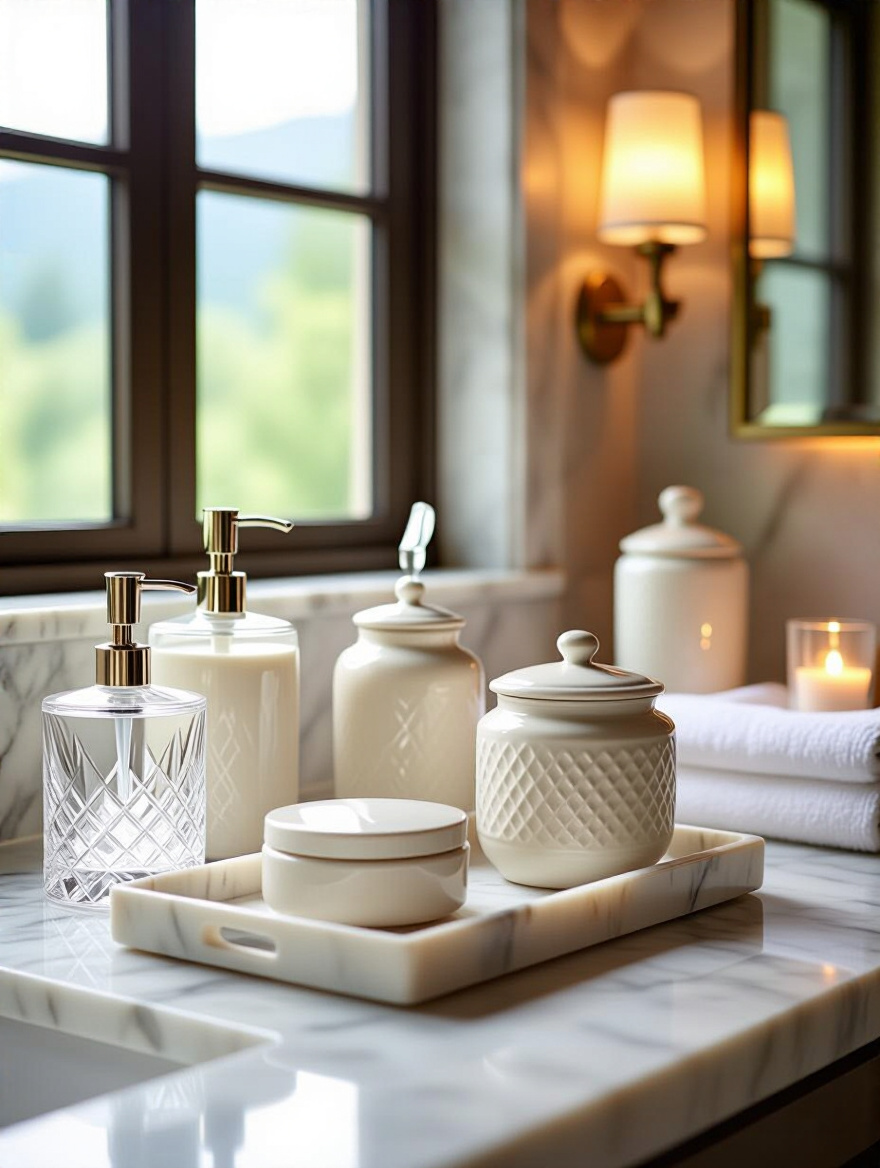
This doesn’t mean you need to hide everything away. Choose a beautiful tray of wood or stone to gather a few select items, like a favorite perfume bottle or face oil. This act of curating your countertop turns a cluttered surface into a thoughtful display, a small moment of beauty that greets you every day.
This is about creating a space for your personal rituals, whether that is shaving in the morning or doing your skincare routine at night. Your vanity area should be organized, well-lit, and comfortable. Everything you need should be easily at hand, stored in well-organized drawers.

Consider a comfortable stool if you have the space. The act of sitting down to prepare for the day or wind down at night changes the pace. It turns a rushed routine into a mindful moment of self-care. It signals that this time is for you, and it is valuable. That is a feeling worth creating.
So you see, true bathroom luxury has very little to do with opulence or price tags. It is born from thoughtfulness. It is a series of small, intentional decisions that add up to a feeling of deep comfort, calm, and quiet pleasure. It’s about designing a space that serves your well-being, a personal retreat from the noise of the world.
Don’t just collect ideas. Pick one or two that truly speak to you and start there. Maybe it’s simply buying a set of beautiful white towels or finding the perfect plant. Begin the journey of turning the most functional room in your house into the one that brings you the most peace. Your ultimate home sanctuary awaits, and it is closer than you think.